| Home | Nature Weekly Index |
22 May 2016 | Ricefield Flatsedge | Cyperus iria |
Two sedeges had grown in the same pot that I newly prepared to grow the Balloon Vine (Cardiospermum halicacabum). Though all kind of seeds started to sprout from the soil at the same time, the 2 sedges had raced ahead of the pack in term of height. At first, I thought they might be the offspring of the Roadside Flatsedge (Cyperus sphacelatus) that had been growing for some time in another pot. The Roadside Flatsedge was still in the same spot for more than 6 months now and it did not spread; just new shoots appearing from the base of the plant. As for the new sedges, as soon as the spikelets (inflorescence) appeared, its identity was also unveiled. They were Ricefield Flatsedge (Cyperus iria). One of them had become the support for the Balloon Vine.
Ricefield Flatsedge has light red fibrous roots. I had to sacrify one of them in order to check on its roots. It had reached a height of around 52 centimetres (cm) before I pull it out from the soil. The fruits or seeds are light brown and about 1 millimetre long. They looked very similar to that from the Roadside Flatsedge. The longest stalk that held the inflorescence clusters was about 9 am long.
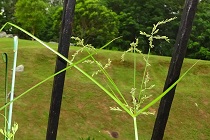
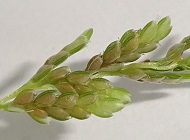
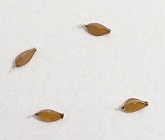
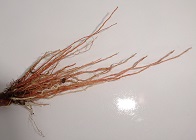
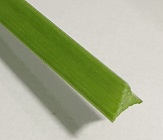
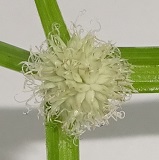 Ricefield Flatsedge is considered a noxious weed in rice field. Its occurrence is worldwide. In
a publication in 2011 that study the inhibitory effect
of this sedge on rice species in Malaysia, it was referred to as Grasshopper's Cyperus. A potential biocontrol agent
(a fungus), which caused leaf blight of this sedge, was
recently identified in India. Leaf blight
is a disease where leaves become discoloured, turn brown and eventually died. There was
another report of a different fungus found
on this sedge back in 1961.
Ricefield Flatsedge is considered a noxious weed in rice field. Its occurrence is worldwide. In
a publication in 2011 that study the inhibitory effect
of this sedge on rice species in Malaysia, it was referred to as Grasshopper's Cyperus. A potential biocontrol agent
(a fungus), which caused leaf blight of this sedge, was
recently identified in India. Leaf blight
is a disease where leaves become discoloured, turn brown and eventually died. There was
another report of a different fungus found
on this sedge back in 1961.
Ricefield Flatsedge was the fifth sedge that sprout spontaneously in my potted area over the years. I had shared the first 3 in a post in September last year. The fourth one being the White Kyllinga (Kyllinga nemoralis), which came along in the soil when I brought the Erigeron bellioides home from a carpark ground in January this year. Its identity was also a mystery until this week when its first compact white-head inflorescence appeared.